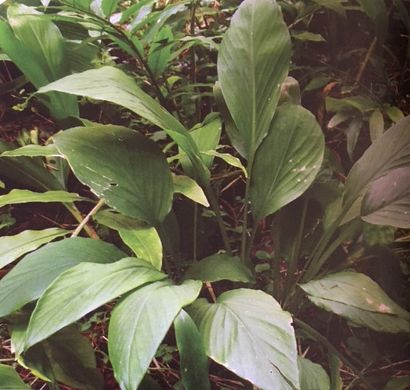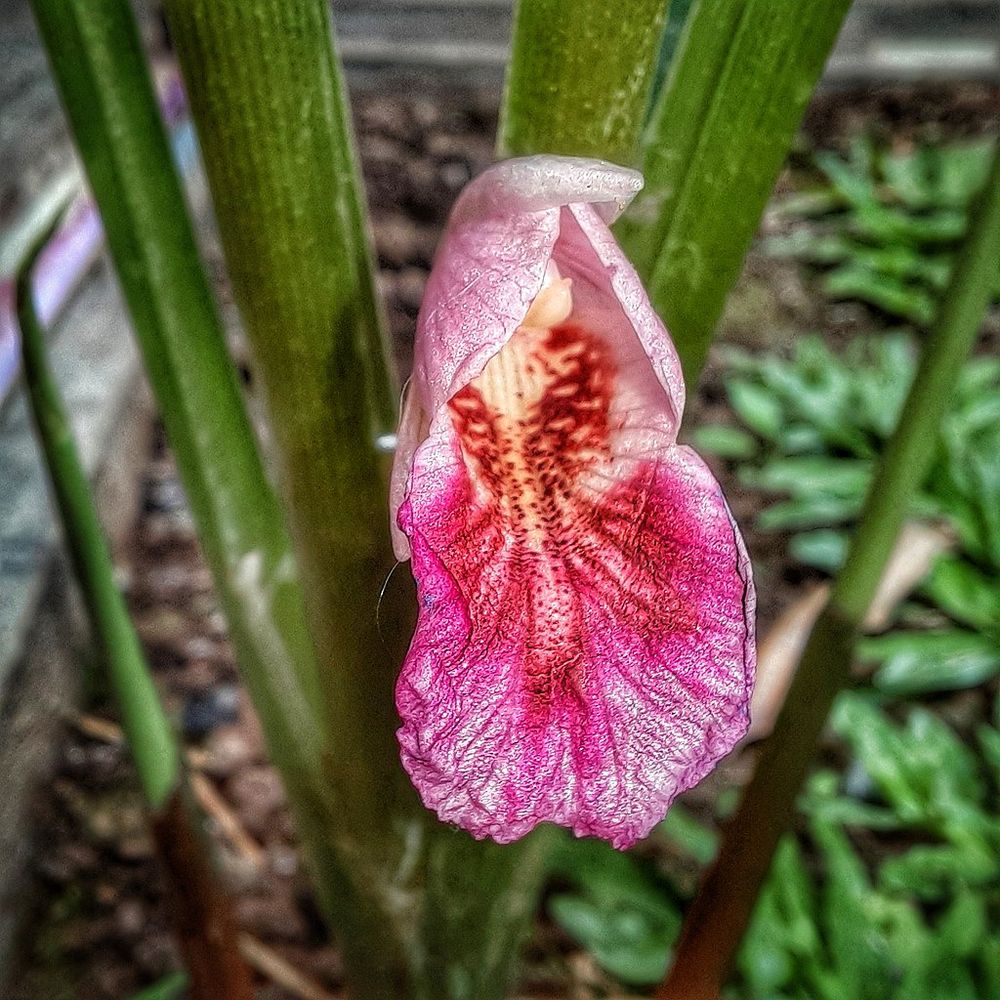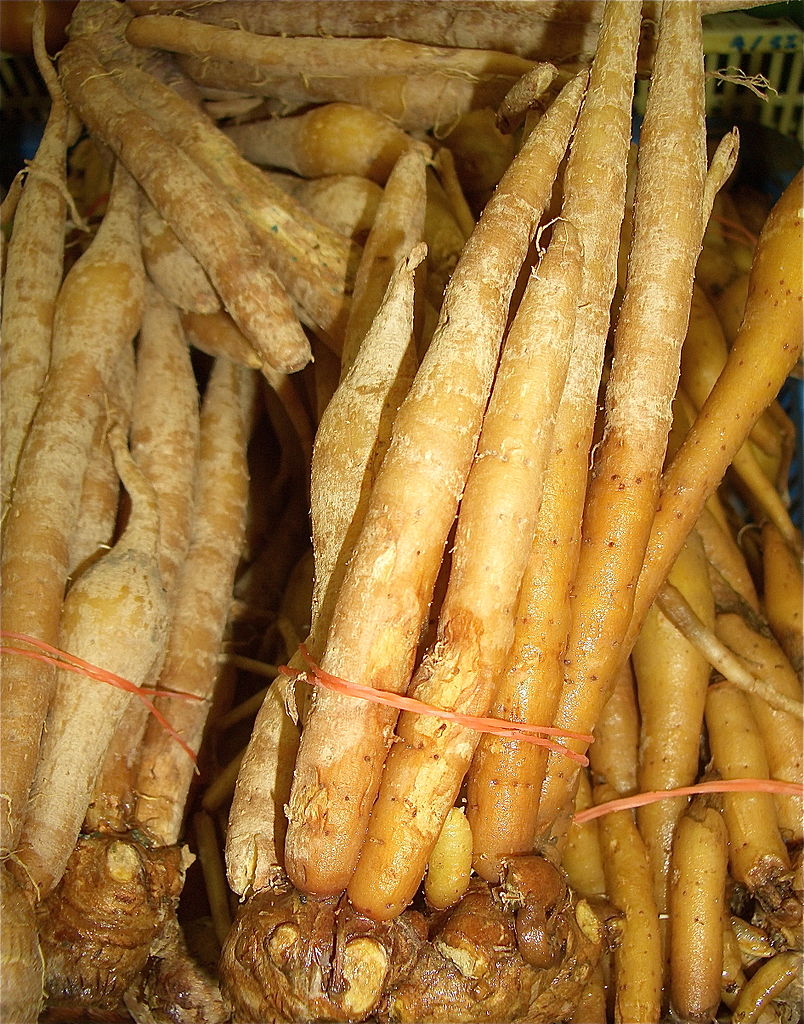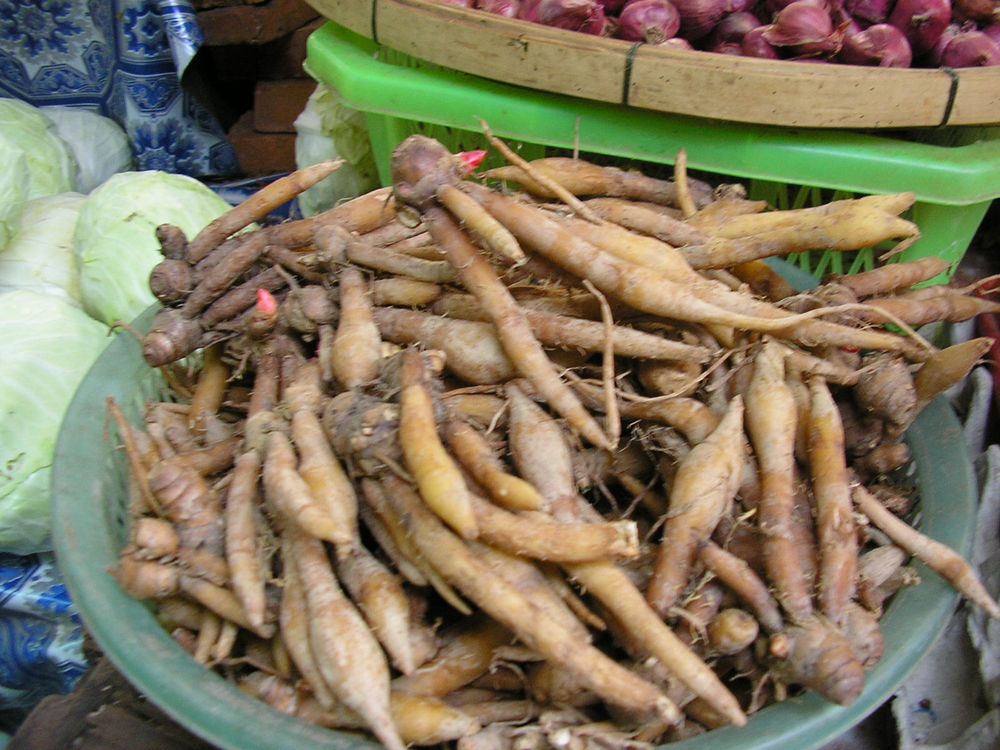The family of Zingiberaceae, whose flowers are among the most spectacular in the plant world, is rich in culinary and medicinal plants. For the Lao people, the three fundamental ones are ginger, turmeric, and galangal, but there are many others as our region is the birthplace of this family, with botanists still discovering new specimens. In the Kaempferia genus, new taxa with local names have been discovered since 2000, such as K. attapeuensis and K. champasakensis, for example.
Belonging to this genus, often considered synonymous with Boesenbergia, in Laos, they use houa ka say, which is sold in markets in the form of small packages of root resembling a finger (referred to as Fingerroot in English). Laotians often use the Thai name houa krachai; the term “houa” in both languages clearly indicates the used part, the “head,” but also the “round and useful root.”
Boesenbergia rotunda is a small herb widely cultivated, reaching 30 to 50cm in height. Its rhizome consists of many small cylindrical roots with pointed ends, revealing a yellow core under a brown skin. Three or four lanceolate leaves emerge from the ground, followed by a terminal inflorescence with red bracts supporting a small white flower marbled with pink.
Houa ka say is highly aromatic, providing a spicy, pungent, and acidic note to many dishes, including various curries, vegetable soups, and some stews. However, Laotian cooks often consider the use of this rhizome as more of a Thai specificity, especially for making khao poun kheng kay, and also in Khmer cuisine to prepare amok.
Like most rhizomes in the family, this one has numerous uses in traditional Laotian medicine, recommended for treating mouth diseases, ulcers, various fungal infections, and believed to have a positive effect on digestion and intestinal disorders. It also has a strong reputation as an aphrodisiac in the region, leading to significant speculation in the market for medicinal plants. Tinctures of krachai are offered in herbal shops as a sexual stimulant. However, the conclusion of a study published in the Asian Journal of Andrology is clear: “B. rotunda does not affect sexual behavior nor serum androgenic levels.”
La famille des Zingibéracées, dont les fleurs sont parmi les plus spectaculaires du monde végétal, est riche en plantes condimentaires et médicinales; pour les Lao, les trois fondamentales sont le gingembre, le curcuma et le galanga, mais il y en a bien d’autres car notre région est le berceau de cette famille dont les botanistes découvrent encore de nouveaux spécimen; ainsi dans le genre Kaempferia ont étés découverts depuis 2000 de nouveaux taxons aux noms bien de chez nous: K. attapeuensis, K. champasakensis par exemple.
Appartenant à ce genre, souvent considéré comme synonyme de Boesenbergia, on utilise au Laos houa ka say qui est vendu sur les marchés sous forme de petits paquets de racines ayant la forme d’un doigt (l’anglais dit Fingerroot). Les Lao emploient souvent d’ailleurs le nom thaï houa krachai; le terme « houa », dans les deux langues, indique bien la partie utilisée, la « tête » mais aussi la « racine ronde » et utile.
Boesenbergia rotunda est une petite herbe largement cultivée de 30 à 50cm de haut. Son rhizome se compose de nombreuses petites racines cylindriques au bout pointu dont l’enveloppe brune découvre un cœur jaune. 3 ou 4 feuilles lancéolées surgissent de terre, suivies d’une inflorescence terminale aux bractées rouges soutenant une petite fleur blanche marbrée de rose.
Houa ka say est très aromatique et donne une note épicée, piquante et acide à la fois, à de nombreux plats: les différents curry, les soupes de légumes, certains ragoûts; les cuisinières lao estiment cependant que l’utilisation de ce rhizome est plutôt une spécificité thaï, en particulier pour faire le khao poun kheng kay et également khmer pour préparer les amok.
Comme la plupart des rhizomes de la famille, celui-ci a de nombreux usages en médecine traditionnelle lao; on le recommande pour traiter les maladies de la bouche, les aphtes, les ulcères, différentes mycoses; il aurait aussi une action positive sur la digestion et les troubles intestinaux; enfin il a une solide réputation d’aphrodisiaque dans toute la région. Ce dernier usage donne lieu à une spéculation importante sur le marché des plantes médicinales et l’on vous propose dans les herboristeries des teintures de krachai comme stimulant sexuel. Cependant la conclusion d’une étude publiée dans Asian Journal of Andrology est formelle: « B. rotunda does not affect sexual behaviour nor serum androgenic levels ».




The family of Zingiberaceae, whose flowers are among the most spectacular in the plant world, is rich in culinary and medicinal plants. For the Lao people, the three fundamental ones are ginger, turmeric, and galangal, but there are many others as our region is the birthplace of this family, with botanists still discovering new specimens. In the Kaempferia genus, new taxa with local names have been discovered since 2000, such as K. attapeuensis and K. champasakensis, for example.
Belonging to this genus, often considered synonymous with Boesenbergia, in Laos, they use houa ka say, which is sold in markets in the form of small packages of root resembling a finger (referred to as Fingerroot in English). Laotians often use the Thai name houa krachai; the term “houa” in both languages clearly indicates the used part, the “head,” but also the “round and useful root.”
Boesenbergia rotunda is a small herb widely cultivated, reaching 30 to 50cm in height. Its rhizome consists of many small cylindrical roots with pointed ends, revealing a yellow core under a brown skin. Three or four lanceolate leaves emerge from the ground, followed by a terminal inflorescence with red bracts supporting a small white flower marbled with pink.
Houa ka say is highly aromatic, providing a spicy, pungent, and acidic note to many dishes, including various curries, vegetable soups, and some stews. However, Laotian cooks often consider the use of this rhizome as more of a Thai specificity, especially for making khao poun kheng kay, and also in Khmer cuisine to prepare amok.
Like most rhizomes in the family, this one has numerous uses in traditional Laotian medicine, recommended for treating mouth diseases, ulcers, various fungal infections, and believed to have a positive effect on digestion and intestinal disorders. It also has a strong reputation as an aphrodisiac in the region, leading to significant speculation in the market for medicinal plants. Tinctures of krachai are offered in herbal shops as a sexual stimulant. However, the conclusion of a study published in the Asian Journal of Andrology is clear: “B. rotunda does not affect sexual behavior nor serum androgenic levels.”
La famille des Zingibéracées, dont les fleurs sont parmi les plus spectaculaires du monde végétal, est riche en plantes condimentaires et médicinales; pour les Lao, les trois fondamentales sont le gingembre, le curcuma et le galanga, mais il y en a bien d’autres car notre région est le berceau de cette famille dont les botanistes découvrent encore de nouveaux spécimen; ainsi dans le genre Kaempferia ont étés découverts depuis 2000 de nouveaux taxons aux noms bien de chez nous: K. attapeuensis, K. champasakensis par exemple.
Appartenant à ce genre, souvent considéré comme synonyme de Boesenbergia, on utilise au Laos houa ka say qui est vendu sur les marchés sous forme de petits paquets de racines ayant la forme d’un doigt (l’anglais dit Fingerroot). Les Lao emploient souvent d’ailleurs le nom thaï houa krachai; le terme « houa », dans les deux langues, indique bien la partie utilisée, la « tête » mais aussi la « racine ronde » et utile.
Boesenbergia rotunda est une petite herbe largement cultivée de 30 à 50cm de haut. Son rhizome se compose de nombreuses petites racines cylindriques au bout pointu dont l’enveloppe brune découvre un cœur jaune. 3 ou 4 feuilles lancéolées surgissent de terre, suivies d’une inflorescence terminale aux bractées rouges soutenant une petite fleur blanche marbrée de rose.
Houa ka say est très aromatique et donne une note épicée, piquante et acide à la fois, à de nombreux plats: les différents curry, les soupes de légumes, certains ragoûts; les cuisinières lao estiment cependant que l’utilisation de ce rhizome est plutôt une spécificité thaï, en particulier pour faire le khao poun kheng kay et également khmer pour préparer les amok.
Comme la plupart des rhizomes de la famille, celui-ci a de nombreux usages en médecine traditionnelle lao; on le recommande pour traiter les maladies de la bouche, les aphtes, les ulcères, différentes mycoses; il aurait aussi une action positive sur la digestion et les troubles intestinaux; enfin il a une solide réputation d’aphrodisiaque dans toute la région. Ce dernier usage donne lieu à une spéculation importante sur le marché des plantes médicinales et l’on vous propose dans les herboristeries des teintures de krachai comme stimulant sexuel. Cependant la conclusion d’une étude publiée dans Asian Journal of Andrology est formelle: « B. rotunda does not affect sexual behaviour nor serum androgenic levels ».








The family of Zingiberaceae, whose flowers are among the most spectacular in the plant world, is rich in culinary and medicinal plants. For the Lao people, the three fundamental ones are ginger, turmeric, and galangal, but there are many others as our region is the birthplace of this family, with botanists still discovering new specimens. In the Kaempferia genus, new taxa with local names have been discovered since 2000, such as K. attapeuensis and K. champasakensis, for example.
Belonging to this genus, often considered synonymous with Boesenbergia, in Laos, they use houa ka say, which is sold in markets in the form of small packages of root resembling a finger (referred to as Fingerroot in English). Laotians often use the Thai name houa krachai; the term “houa” in both languages clearly indicates the used part, the “head,” but also the “round and useful root.”
Boesenbergia rotunda is a small herb widely cultivated, reaching 30 to 50cm in height. Its rhizome consists of many small cylindrical roots with pointed ends, revealing a yellow core under a brown skin. Three or four lanceolate leaves emerge from the ground, followed by a terminal inflorescence with red bracts supporting a small white flower marbled with pink.
Houa ka say is highly aromatic, providing a spicy, pungent, and acidic note to many dishes, including various curries, vegetable soups, and some stews. However, Laotian cooks often consider the use of this rhizome as more of a Thai specificity, especially for making khao poun kheng kay, and also in Khmer cuisine to prepare amok.
Like most rhizomes in the family, this one has numerous uses in traditional Laotian medicine, recommended for treating mouth diseases, ulcers, various fungal infections, and believed to have a positive effect on digestion and intestinal disorders. It also has a strong reputation as an aphrodisiac in the region, leading to significant speculation in the market for medicinal plants. Tinctures of krachai are offered in herbal shops as a sexual stimulant. However, the conclusion of a study published in the Asian Journal of Andrology is clear: “B. rotunda does not affect sexual behavior nor serum androgenic levels.”
La famille des Zingibéracées, dont les fleurs sont parmi les plus spectaculaires du monde végétal, est riche en plantes condimentaires et médicinales; pour les Lao, les trois fondamentales sont le gingembre, le curcuma et le galanga, mais il y en a bien d’autres car notre région est le berceau de cette famille dont les botanistes découvrent encore de nouveaux spécimen; ainsi dans le genre Kaempferia ont étés découverts depuis 2000 de nouveaux taxons aux noms bien de chez nous: K. attapeuensis, K. champasakensis par exemple.
Appartenant à ce genre, souvent considéré comme synonyme de Boesenbergia, on utilise au Laos houa ka say qui est vendu sur les marchés sous forme de petits paquets de racines ayant la forme d’un doigt (l’anglais dit Fingerroot). Les Lao emploient souvent d’ailleurs le nom thaï houa krachai; le terme « houa », dans les deux langues, indique bien la partie utilisée, la « tête » mais aussi la « racine ronde » et utile.
Boesenbergia rotunda est une petite herbe largement cultivée de 30 à 50cm de haut. Son rhizome se compose de nombreuses petites racines cylindriques au bout pointu dont l’enveloppe brune découvre un cœur jaune. 3 ou 4 feuilles lancéolées surgissent de terre, suivies d’une inflorescence terminale aux bractées rouges soutenant une petite fleur blanche marbrée de rose.
Houa ka say est très aromatique et donne une note épicée, piquante et acide à la fois, à de nombreux plats: les différents curry, les soupes de légumes, certains ragoûts; les cuisinières lao estiment cependant que l’utilisation de ce rhizome est plutôt une spécificité thaï, en particulier pour faire le khao poun kheng kay et également khmer pour préparer les amok.
Comme la plupart des rhizomes de la famille, celui-ci a de nombreux usages en médecine traditionnelle lao; on le recommande pour traiter les maladies de la bouche, les aphtes, les ulcères, différentes mycoses; il aurait aussi une action positive sur la digestion et les troubles intestinaux; enfin il a une solide réputation d’aphrodisiaque dans toute la région. Ce dernier usage donne lieu à une spéculation importante sur le marché des plantes médicinales et l’on vous propose dans les herboristeries des teintures de krachai comme stimulant sexuel. Cependant la conclusion d’une étude publiée dans Asian Journal of Andrology est formelle: « B. rotunda does not affect sexual behaviour nor serum androgenic levels ».


